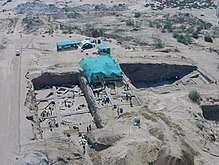Tell El Sakan
Tel El Sakan was an important ancient Canaanite/Egyptian maritime settlement during the early Bronze Age, situated at the mouth of Wadi Ghazzeh, in Gaza strip. Its geographical situation endowed it with a position of importance at the crossroads on the land based trade routes to Arabia, the Egyptian empire to the south and the Canaan region to the north.

Occupation history
The site (dated between 3500-2350 BCE) covered over 5 hectares. It appears to be the predecessor to the Tell al-Ajjul settlement, where geomorphological dynamics of the estuary caused settlement trans-location or abandonment. The site dates from a period prior to the Egyptian military domination of the Levant.
There were three consecutive building-phases, correlating with three strata of occupation.
The earliest Egyptian walled town
The Bronze Age port dates to the end of the 4th millennium BC, and was contemporary with En Besor, an Egyptian First Dynasty Staging Post along the "ways of Horus" trade route in the Northern Negev.[1][2] By comparison, Tel es-Sakan was larger and surrounded by a city-wall, the earliest Egyptian town wall datable with any certainty.
Other finds of Egyptian or "Egyptianizing" pottery from this early period have also been found at the sites of Tel Erani, Arad, Tell el-Khuweilifeh/Tel Halif, Yarmuth, and Tel Lod. Nevertheless, the quantity of such pottery is rather small compared to the amount of the Levantine Early Bronze Age pottery at these sites.
El Sakan may have been the centre of Egyptian settlement and colonisation for this whole coastal area during the Early Dynastic Period (Egypt).
Canaanite city
The site was reoccupied in the Early Bronze III (EBIII) period, when a Canaanite walled city was built here. This comprises seven strata of occupation at the site. The walls at that time were 8m thick and built with sun-dried mud bricks.
The final phase of occupation was EBII (third millennium BC). Remains of sheep, goat and cattle were discovered, as well as fish bones and shells. Wheat, barley, vegetables, olives, and grapes were cultivated.
This Canaanite settlement is dated solely to the Early Bronze period, when the major sites of southwestern Canaan reached their greatest prosperity. Then the settlement was finally abandoned around 2400-2350 BC.
Nevertheless, the occupation continued during the Middle and Late Bronze Age at two sites nearby, Tel-al-Ajjul and al-Mughraqa.
Another site further south at Deir al-Balah was occupied during the 14th–12th centuries BC, the time of New Kingdom (Late Bronze Age).[3]
Location
The site is located about 500 metres to the north of Tell el-Ajjul.[4]
It was previously covered by a sand dune, and was discovered by chance in 1998 during construction of a new housing complex, and construction work was temporarily suspended to allow an archaeological investigation to be conducted.[5]
In 2017 Hamas authorities leveled the site with bulldozers to make way for military bases and construction projects, despite local protests by Gazans protesting destruction of ancient Palestinian archaeological heritage.[6][7][8]
Footnotes
- McGovern, Patrick E. (2003) Ancient Wine: The Search for the Origins of Viniculture, Princeton University Press, ISBN 0-691-07080-6 p. 101
- Hornsey, Ian Spencer (2003) A History of Beer and Brewing Royal Society of Chemistry (Great Britain) ISBN 0-85404-630-5 p 53
- Deir el-Balah BIBLICAL ARCHAEOLOGY SOCIETY, 2012
- Territoires autonomes palestiniens : Tell es-Sakan Archéologies et Sciences de l’Antiquité (ArScAn) -- www.arscan.fr
- Ancient Perspectives on Egypt By Roger Matthews, Cornelia Roemer, University College, London Institute of Archaeology Published by Routledge Cavendish, 2003 ISBN 1-84472-002-0 pp 24-25 and pp 34-37
- In Gaza, Hamas levels an ancient Canaanite archaeological treasure, Times of Israel, Fares Akram, 6 October 2017
- "Gazans protest destruction of archaeological site by Hamas: they are trying to wipe out Palestinian identity". MEMRI. (Arabic TV). October 17, 2017. Retrieved 10 September 2018.
- "Gazans protest destruction of archaeological site by Hamas: they are trying to wipe out Palestinian identity - Transcript". MEMRI. October 17, 2017. Retrieved 10 September 2018.
Bibliography
- 2001 Miroschedji, P. de, et M. Sadek, — « Gaza et l’Égypte de l’époque prédynastique à l’Ancien Empire : Premiers résultats des fouilles de Tell es-Sakan. » Bulletin de la Société Française d’égyptologie 152 : 28-52.
- 2001 Miroschedji, P. de, et M. Sadek ; Faltings, D. ; Boulez, V. ; Naggiar, L. ; Sykes, N. Tengberg, M. — « Les fouilles de Tell es-Sakan (Gaza) : nouvelles données sur les contacts égypto-cananéens aux IVe-IIIe millénaires. » Paléorient 27/2 : 75-104.
- 2012 Miroschedji, P. de, — Egypt and Southern Canaan in the Third Millennium BCE : Uni’s Asiatic Campaigns Revisited. Pp. 265-292 dans : Mayer Gruber, Shmuel Ahituv, Gunnar Lehmann, and Zipora Talshir, eds., All the Wisdom of the East, Studies in Near Eastern Archaeology and History in Honor of Eliezer D. Oren. Orbis biblicus et orientalis 255. Fribourg : Academic Press, et Göttingen : Vandenhoeck & Ruprecht.
- 2015 Miroschedji, P. de, –– “Les relations entre l’Égypte et le Levant aux IVe et IIIe millénaires à la lumière des fouilles de Tell es-Sakan.” Comptes rendus de l’Académie des Inscriptions et Belles-Lettres 2015 (avril-juin) : 1003–1038.